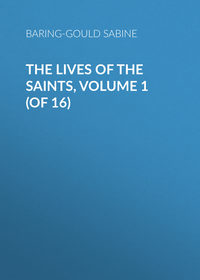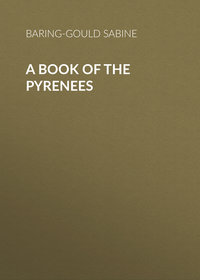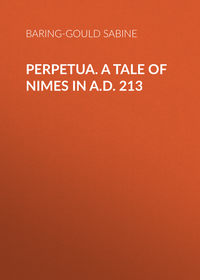 полная версия
полная версияCurious Myths of the Middle Ages
It is probable that the foundation of the whole Prester-John myth lay in the report which reached Europe of the wonderful successes of Nestorianism in the East, and there seems reason to believe that the famous letter given above was a Nestorian fabrication. It certainly looks un-European; the gorgeous imagery is thoroughly Eastern, and the disparaging tone in which Rome is spoken of could hardly have been the expression of Western feelings. The letter has the object in view of exalting the East in religion and arts to an undue eminence at the expense of the West, and it manifests some ignorance of European geography, when it speaks of the land extending from Spain to the Polar Sea. Moreover, the sites of the patriarchates, and the dignity conferred on that of St. Thomas, are indications of a Nestorian bias.
A brief glance at the history of this heretical Church may be of value here, as showing that there really was a foundation for the wild legends concerning a Christian empire in the East, so prevalent in Europe. Nestorius, a priest of Antioch and a disciple of St. Chrysostom, was elevated by the emperor to the patriarchate of Constantinople, and in the year 428 began to propagate his heresy, denying the hypostatic union. The Council of Ephesus denounced him, and, in spite of the emperor and court, Nestorius was anathematized and driven into exile. His sect spread through the East, and became a flourishing church. It reached to China, where the emperor was all but converted; its missionaries traversed the frozen tundras of Siberia, preaching their maimed Gospel to the wild hordes which haunted those dreary wastes; it faced Buddhism, and wrestled with it for the religious supremacy in Thibet; it established churches in Persia and in Bokhara; it penetrated India; it formed colonies in Ceylon, in Siam, and in Sumatra; so that the Catholicos or Pope of Bagdad exercised sway more extensive than that ever obtained by the successor of St. Peter. The number of Christians belonging to that communion probably exceeded that of the members of the true Catholic Church in East and West. But the Nestorian Church was not founded on the Rock; it rested on Nestorius; and when the rain descended, and the winds blew, and the floods came, and beat upon that house, it fell, leaving scarce a fragment behind.
Rubruquis the Franciscan, who in 1253 was sent on a mission into Tartary, was the first to let in a little light on the fable. He writes, “The Catai dwelt beyond certain mountains across which I wandered, and in a plain in the midst of the mountains lived once an important Nestorian shepherd, who ruled over the Nestorian people, called Nayman. When Coir-Khan died, the Nestorian people raised this man to be king, and called him King Johannes, and related of him ten times as much as the truth. The Nestorians thereabouts have this way with them, that about nothing they make a great fuss, and thus they have got it noised abroad that Sartach, Mangu-Khan, and Ken-Khan were Christians, simply because they treated Christians well, and showed them more honor than other people. Yet, in fact, they were not Christians at all. And in like manner the story got about that there was a great King John. However, I traversed his pastures, and no one knew anything about him, except a few Nestorians. In his pastures lives Ken-Khan, at whose court was Brother Andrew, whom I met on my way back. This Johannes had a brother, a famous shepherd, named Unc, who lived three weeks’ journey beyond the mountains of Caracatais.”
This Unk-Khan was a real individual; he lost his life in the year 1203. Kuschhik, prince of the Nayman, and follower of Kor-Khan, fell in 1218.
Marco Polo, the Venetian traveller (1254-1324), identifies Unk-Khan with Prester John; he says, “I will now tell you of the deeds of the Tartars, how they gained the mastery, and spread over the whole earth. The Tartars dwelt between Georgia and Bargu, where there is a vast plain and level country, on which are neither cities nor forts, but capital pasturage and water. They had no chief of their own, but paid to Prester Johannes tribute. Of the greatness of this Prester Johannes, who was properly called Un-Khan, the whole world spake; the Tartars gave him one of every ten head of cattle. When Prester John noticed that they were increasing, he feared them, and planned how he could injure them. He determined therefore to scatter them, and he sent barons to do this. But the Tartars guessed what Prester John purposed … and they went away into the wide wastes of the North, where they might be beyond his reach.” He then goes on to relate how Tschengis-(Jenghiz-)Khan became the head of the Tartars, and how he fought against Prester John, and, after a desperate fight, overcame and slew him.
The Syriac Chronicle of the Jacobite Primate, Gregory Bar-Hebræus (born 1226, died 1286), also identifies Unk-Khan with Prester John. “In the year of the Greeks 1514, of the Arabs 599 (A. D. 1202), when Unk-Khan, who is the Christian King John, ruled over a stock of the barbarian Hunns, called Kergt, Tschingys-Khan served him with great zeal. When John observed the superiority and serviceableness of the other, he envied him, and plotted to seize and murder him. But two sons of Unk-Khan, having heard this, told it to Tschingys; whereupon he and his comrades fled by night, and secreted themselves. Next morning Unk-Khan took possession of the Tartar tents, but found them empty. Then the party of Tschingys fell upon him, and they met by the spring called Balschunah, and the side of Tschingys won the day; and the followers of Unk-Khan were compelled to yield. They met again several times, till Unk-Khan was utterly discomfited, and was slain himself, and his wives, sons, and daughters carried into captivity. Yet we must consider that King John the Kergtajer was not cast down for nought; nay, rather, because he had turned his heart from the fear of Christ his Lord, who had exalted him, and had taken a wife of the Zinish nation, called Quarakhata. Because he forsook the religion of his ancestors and followed strange gods, therefore God took the government from him, and gave it to one better than he, and whose heart was right before God.”
Some of the early travellers, such as John de Plano Carpini and Marco Polo, in disabusing the popular mind of the belief in Prester John as a mighty Asiatic Christian monarch, unintentionally turned the popular faith in that individual into a new direction. They spoke of the black people of Abascia in Ethiopia, which, by the way, they called Middle India, as a great people subject to a Christian monarch.
Marco Polo says that the true monarch of Abyssinia is Christ; but that it is governed by six kings, three of whom are Christians and three Saracens, and that they are in league with the Soudan of Aden.
Bishop Jordanus, in his description of the world, accordingly sets down Abyssinia as the kingdom of Prester John; and such was the popular impression, which was confirmed by the appearance at intervals of ambassadors at European courts from the King of Abyssinia. The discovery of the Cape of Good Hope was due partly to a desire manifested in Portugal to open communications with this monarch,22 and King John II. sent two men learned in Oriental languages through Egypt to the court of Abyssinia. The might and dominion of this prince, who had replaced the Tartar chief in the popular creed as Prester John, was of course greatly exaggerated, and was supposed to extend across Arabia and Asia to the wall of China. The spread of geographical knowledge has contracted the area of his dominions, and a critical acquaintance with history has exploded the myth which invested Unk-Khan, the nomad chief, with all the attributes of a demigod, uniting in one the utmost pretensions of a Pope and the proudest claims of a monarch.
The Divining Rod
FROM the remotest period a rod has been regarded as the symbol of power and authority, and Holy Scripture employs it in the popular sense. Thus David speaks of “Thy rod and Thy staff comforting me;” and Moses works his miracles before Pharaoh with the rod as emblem of Divine commission. It was his rod which became a serpent, which turned the water of Egypt into blood, which opened the waves of the Red Sea and restored them to their former level, which “smote the rock of stone so that the water gushed out abundantly.” The rod of Aaron acted an oracular part in the contest with the princes; laid up before the ark, it budded and brought forth almonds. In this instance we have it no longer as a symbol of authority, but as a means of divining the will of God. And as such it became liable to abuse; thus Hosea rebukes the chosen people for practising similar divinations. “My people ask counsel at their stocks, and their staff declareth unto them.”23
Long before this, Jacob had made a different use of rods, employing them as a charm to make his father-in-law’s sheep bear pied and spotted lambs.
We find rhabdomancy a popular form of divination among the Greeks, and also among the Romans. Cicero in his “De Officiis” alludes to it. “If all that is needful for our nourishment and support arrives to us by means of some divine rod, as people say, then each of us, free from all care and trouble, may give himself up to the exclusive pursuit of study and science.”
Probably it is to this rod that the allusion of Ennius, as the agent in discovering hidden treasures, quoted in the first book of his “De Divinatione,” refers.
According to Vetranius Maurus, Varro left a satire on the “Virgula divina,” which has not been preserved. Tacitus tells us that the Germans practised some sort of divination by means of rods. “For the purpose their method is simple. They cut a rod off some fruit-tree into bits, and after having distinguished them by various marks, they cast them into a white cloth… Then the priest thrice draws each piece, and explains the oracle according to the marks.” Ammianus Marcellinus says that the Alains employed an osier rod.
The fourteenth law of the Frisons ordered that the discovery of murders should be made by means of divining rods used in Church. These rods should be laid before the altar, and on the sacred relics, after which God was to be supplicated to indicate the culprit. This was called the Lot of Rods, or Tan-teen, the Rod of Rods.
But the middle ages was the date of the full development of the superstition, and the divining rod was believed to have efficacy in discovering hidden treasures, veins of precious metal, springs of water, thefts, and murders. The first notice of its general use among late writers is in the “Testamentum Novum,” lib. i. cap. 25, of Basil Valentine, a Benedictine monk of the fifteenth century. Basil speaks of the general faith in and adoption of this valuable instrument for the discovery of metals, which is carried by workmen in mines, either in their belts or in their caps. He says that there are seven names by which this rod is known, and to its excellences under each title he devotes a chapter of his book. The names are: Divine Rod, Shining Rod, Leaping Rod, Transcendent Rod, Trembling Rod, Dipping Rod, Superior Rod. In his admirable treatise on metals, Agricola speaks of the rod in terms of disparagement; he considers its use as a relic of ancient magical forms, and he says that it is only irreligious workmen who employ it in their search after metals. Goclenius, however, in his treatise on the virtue of plants, stoutly does battle for the properties of the hazel rod. Whereupon Roberti, a Flemish Jesuit, falls upon him tooth and nail, disputes his facts, overwhelms him with abuse, and gibbets him for popular ridicule. Andreas Libavius, a writer I have already quoted in my article on the Wandering Jew, undertook a series of experiments upon the hazel divining rod, and concluded that there was truth in the popular belief. The Jesuit Kircher also “experimentalized several times on wooden rods which were declared to be sympathetic with regard to certain metals, by placing them on delicate pivots in equilibrium; but they never turned on the approach of metal.” (De Arte Magnetica.) However, a similar course of experiments over water led him to attribute to the rod the power of indicating subterranean springs and water-courses; “I would not affirm it,” he says, “unless I had established the fact by my own experience.”
Dechales, another Jesuit, author of a treatise on natural springs, and of a huge tome entitled “Mundus Mathematicus,” declared in the latter work, that no means of discovering sources is equal to the divining rod; and he quotes a friend of his who, with a hazel rod in his hand, could discover springs with the utmost precision and facility, and could trace on the surface of the ground the course of a subterranean conduit. Another writer, Saint-Romain, in his “Science dégagée des Chimères de l’École,” exclaims, “Is it not astonishing to see a rod, which is held firmly in the hands, bow itself and turn visibly in the direction of water or metal, with more or less promptitude, according as the metal or the water are near or remote from the surface!”
In 1659 the Jesuit Gaspard Schott writes that the rod is used in every town of Germany, and that he had frequent opportunity of seeing it used in the discovery of hidden treasures. “I searched with the greatest care,” he adds, “into the question whether the hazel rod had any sympathy with gold and silver, and whether any natural property set it in motion. In like manner I tried whether a ring of metal, held suspended by a thread in the midst of a tumbler, and which strikes the hours, is moved by any similar force. I ascertained that these effects could only have rise from the deception of those holding the rod or the pendulum, or, may be, from some diabolic impulsion, or, more likely still, because imagination sets the hand in motion.”
The Sieur le Royer, a lawyer of Rouen, in 1674, published his “Traité du Bâton universel,” in which he gives an account of a trial made with the rod in the presence of Father Jean François, who had ridiculed the operation in his treatise on the science of waters, published at Rennes in 1655, and which succeeded in convincing the blasphemer of the divine Rod. Le Royer denies to it the power of picking out criminals, which had been popularly attributed to it, and as had been unhesitatingly claimed for it by Debrio in his “Disquisitio Magica.”
And now I am brought to the extraordinary story of Jacques Aymar, which attracted the attention of Europe to the marvellous properties of the divining rod. I shall give the history of this man in full, as such an account is rendered necessary by the mutilated versions I have seen current in English magazine articles, which follow the lead of Mrs. Crowe, who narrates the earlier portion of this impostor’s career, but says nothing of his exposé and downfall.
On the 5th July, 1692, at about ten o’clock in the evening, a wine-seller of Lyons and his wife were assassinated in their cellar, and their money carried off. On the morrow, the officers of justice arrived, and examined the premises. Beside the corpses, lay a large bottle wrapped in straw, and a bloody hedging bill, which undoubtedly had been the instrument used to accomplish the murder. Not a trace of those who had committed the horrible deed was to be found, and the magistrates were quite at fault as to the direction in which they should turn for a clew to the murderer or murderers.
At this juncture a neighbor reminded the magistrates of an incident which had taken place four years previous. It was this. In 1688 a theft of clothes had been made in Grenoble. In the parish of Crôle lived a man named Jacques Aymar, supposed to be endowed with the faculty of using the divining rod. This man was sent for. On reaching the spot where the theft had been committed, his rod moved in his hand. He followed the track indicated by the rod, and it continued to rotate between his fingers as long as he followed a certain direction, but ceased to turn if he diverged from it in the smallest degree. Guided by his rod, Aymar went from street to street, till he was brought to a standstill before the prison gates. These could not be opened without leave of the magistrate, who hastened to witness the experiment. The gates were unlocked, and Aymar, under the same guidance, directed his steps towards four prisoners lately incarcerated. He ordered the four to be stood in a line, and then he placed his foot on that of the first. The rod remained immovable. He passed to the second, and the rod turned at once. Before the third prisoner there were no signs; the fourth trembled, and begged to be heard. He owned himself the thief, along with the second, who also acknowledged the theft, and mentioned the name of the receiver of the stolen goods. This was a farmer in the neighborhood of Grenoble. The magistrate and officers visited him and demanded the articles he had obtained. The farmer denied all knowledge of the theft and all participation in the booty. Aymar, however, by means of his rod, discovered the secreted property, and restored it to the persons from whom it had been stolen.
On another occasion Aymar had been in quest of a spring of water, when he felt his rod turn sharply in his hand. On digging at the spot, expecting to discover an abundant source, the body of a murdered woman was found in a barrel, with a rope twisted round her neck. The poor creature was recognized as a woman of the neighborhood who had vanished four months before. Aymar went to the house which the victim had inhabited, and presented his rod to each member of the household. It turned upon the husband of the deceased, who at once took to flight.
The magistrates of Lyons, at their wits’ ends how to discover the perpetrators of the double murder in the wine shop, urged the Procureur du Roi to make experiment of the powers of Jacques Aymar. The fellow was sent for, and he boldly asserted his capacity for detecting criminals, if he were first brought to the spot of the murder, so as to be put en rapport with the murderers.
He was at once conducted to the scene of the outrage, with the rod in his hand. This remained stationary as he traversed the cellar, till he reached the spot where the body of the wine seller had lain; then the stick became violently agitated, and the man’s pulse rose as though he were in an access of fever. The same motions and symptoms manifested themselves when he reached the place where the second victim had lain.
Having thus received his impression, Aymar left the cellar, and, guided by his rod, or rather by an internal instinct, he ascended into the shop, and then stepping into the street, he followed from one to another, like a hound upon the scent, the track of the murderers. It conducted him into the court of the archiepiscopal palace, across it, and down to the gate of the Rhone. It was now evening, and the city gates being all closed, the quest of blood was relinquished for the night.
Next morning Aymar returned to the scent. Accompanied by three officers, he left the gate, and descended the right bank of the Rhone. The rod gave indications of there having been three involved in the murder, and he pursued the traces till two of them led to a gardener’s cottage. Into this he entered, and there he asserted with warmth, against the asseverations of the proprietor to the contrary, that the fugitives had entered his room, had seated themselves at his table, and had drunk wine out of one of the bottles which he indicated. Aymar tested each of the household with his rod, to see if they had been in contact with the murderers. The rod moved over the two children only, aged respectively ten and nine years. These little things, on being questioned, answered, with reluctance, that during their father’s absence on Sunday morning, against his express commands, they had left the door open, and that two men, whom they described, had come in suddenly upon them, and had seated themselves and made free with the wine in the bottle pointed out by the man with the rod. This first verification of the talents of Jacques Aymar convinced some of the sceptical, but the Procurateur Général forbade the prosecution of the experiment till the man had been further tested.
As already stated, a hedging bill had been discovered, on the scene of the murder, smeared with blood, and unquestionably the weapon with which the crime had been committed. Three bills from the same maker, and of precisely the same description, were obtained, and the four were taken into a garden, and secretly buried at intervals. Aymar was then brought, staff in hand, into the garden, and conducted over the spots where lay the bills. The rod began to vibrate as his feet stood upon the place where was concealed the bill which had been used by the assassins, but was motionless elsewhere. Still unsatisfied, the four bills were exhumed and concealed anew. The comptroller of the province himself bandaged the sorcerer’s eyes, and led him by the hand from place to place. The divining rod showed no signs of movement till it approached the blood-stained weapon, when it began to oscillate.
The magistrates were now so far satisfied as to agree that Jacques Aymar should be authorized to follow the trail of the murderers, and have a company of archers to follow him.
Guided by his rod, Aymar now recommenced his pursuit. He continued tracing down the right bank of the Rhone till he came to half a league from the bridge of Lyons. Here the footprints of three men were observed in the sand, as though engaged in entering a boat. A rowing boat was obtained, and Aymar, with his escort, descended the river; he found some difficulty in following the trail upon water; still he was able, with a little care, to detect it. It brought him under an arch of the bridge of Vienne, which boats rarely passed beneath. This proved that the fugitives were without a guide. The way in which this curious journey was made was singular. At intervals Aymar was put ashore to test the banks with his rod, and ascertain whether the murderers had landed. He discovered the places where they had slept, and indicated the chairs or benches on which they had sat. In this manner, by slow degrees, he arrived at the military camp of Sablon, between Vienne and Saint-Valier. There Aymar felt violent agitation, his cheeks flushed, and his pulse beat with rapidity. He penetrated the crowds of soldiers, but did not venture to use his rod, lest the men should take it ill, and fall upon him. He could not do more without special authority, and was constrained to return to Lyons. The magistrates then provided him with the requisite powers, and he went back to the camp. Now he declared that the murderers were not there. He recommenced his pursuit, and descended the Rhone again as far as Beaucaire.
On entering the town he ascertained by means of his rod that those whom he was pursuing had parted company. He traversed several streets, then crowded on account of the annual fair, and was brought to a standstill before the prison doors. One of the murderers was within, he declared; he would track the others afterwards. Having obtained permission to enter, he was brought into the presence of fourteen or fifteen prisoners. Amongst these was a hunchback, who had only an hour previously been incarcerated on account of a theft he had committed at the fair. Aymar applied his rod to each of the prisoners in succession: it turned upon the hunchback. The sorcerer ascertained that the other two had left the town by a little path leading into the Nismes road. Instead of following this track, he returned to Lyons with the hunchback and the guard. At Lyons a triumph awaited him. The hunchback had hitherto protested his innocence, and declared that he had never set foot in Lyons. But as he was brought to that town by the way along which Aymar had ascertained that he had left it, the fellow was recognized at the different houses where he had lodged the night, or stopped for food. At the little town of Bagnols, he was confronted with the host and hostess of a tavern where he and his comrades had slept, and they swore to his identity, and accurately described his companions: their description tallied with that given by the children of the gardener. The wretched man was so confounded by this recognition, that he avowed having staid there, a few days before, along with two Provençals. These men, he said, were the criminals; he had been their servant, and had only kept guard in the upper room whilst they committed the murders in the cellar.
On his arrival in Lyons he was committed to prison, and his trial was decided on. At his first interrogation he told his tale precisely as he had related it before, with these additions: the murderers spoke patois, and had purchased two bills. At ten o’clock in the evening all three had entered the wine shop. The Provençals had a large bottle wrapped in straw, and they persuaded the publican and his wife to descend with them into the cellar to fill it, whilst he, the hunchback, acted as watch in the shop. The two men murdered the wine-seller and his wife with their bills, and then mounted to the shop, where they opened the coffer, and stole from it one hundred and thirty crowns, eight louis-d’ors, and a silver belt. The crime accomplished, they took refuge in the court of a large house, – this was the archbishop’s palace, indicated by Aymar, – and passed the night in it. Next day, early, they left Lyons, and only stopped for a moment at a gardener’s cottage. Some way down the river, they found a boat moored to the bank. This they loosed from its mooring and entered. They came ashore at the spot pointed out by the man with the stick. They staid some days in the camp at Sablon, and then went on to Beaucaire.











